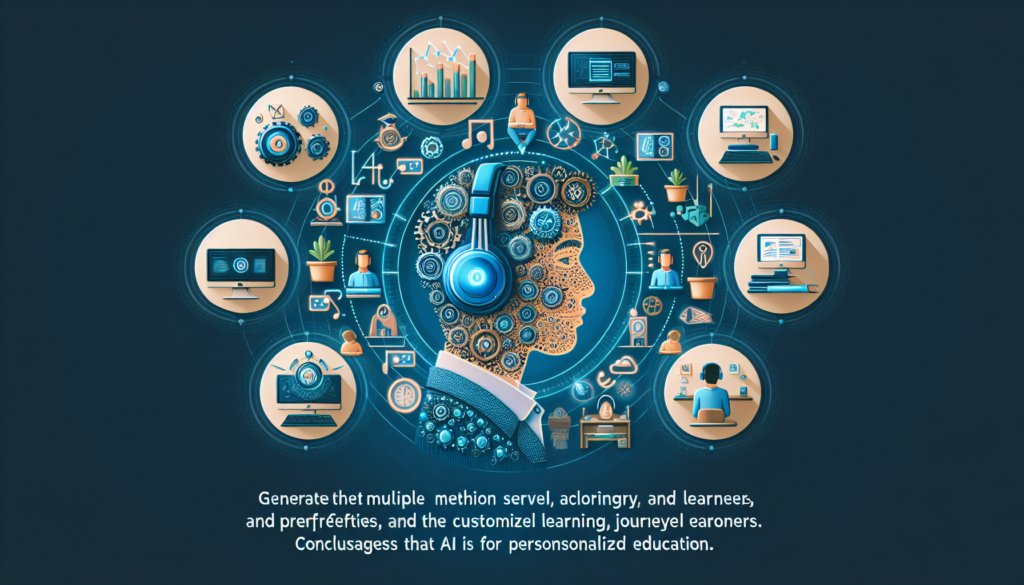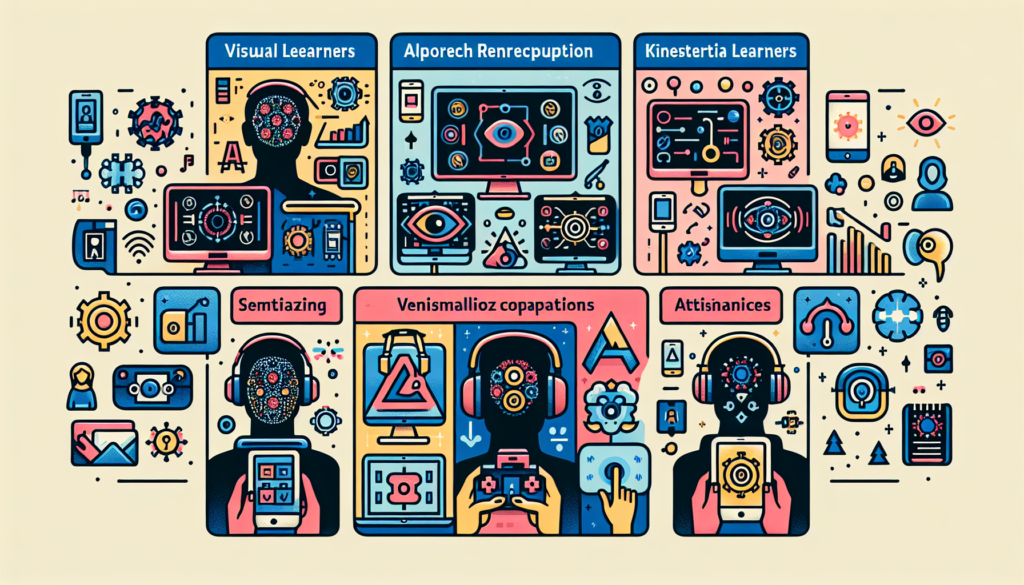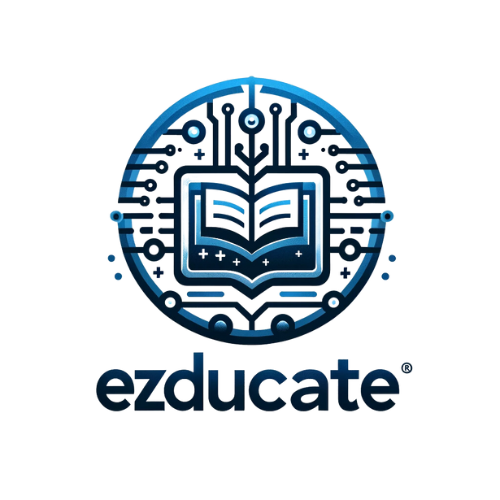Are you someone who learns best through visual illustrations and diagrams? Or perhaps you prefer a more hands-on approach and enjoy interactive activities? No matter your preferred learning style, AI apps have revolutionized the way we learn by catering to individual needs. By utilizing advanced algorithms and machine learning, these intelligent apps adapt to your unique learning style, providing personalized content and recommendations that enhance your educational experience. Whether you’re a visual learner, auditory learner, or kinesthetic learner, AI apps are here to help you learn more efficiently and effectively.

Visual Learners
Importance of visual elements
For visual learners, the importance of visual elements cannot be overstated. These learners thrive on seeing information presented in a visual format, as it helps them visualize concepts and make connections. Visual elements such as graphs, charts, diagrams, and illustrations can significantly enhance their understanding and retention of information. By incorporating visual elements into AI apps, developers can cater to the needs of visual learners and provide them with a more engaging and effective learning experience.
Use of graphics and images
The use of graphics and images is a powerful tool when it comes to catering to visual learners. These learners are more likely to understand and remember information that is presented through visual means rather than solely through text. AI apps can make use of relevant and visually appealing graphics and images to present information in a way that resonates with visual learners. Whether it is using diagrams to explain complex processes or incorporating relevant images to concretize abstract concepts, the integration of visual elements can significantly enhance the learning experience for visual learners.
Interactive visual aids
Visual learners also benefit greatly from interactive visual aids. These aids allow learners to actively engage with the material, promoting a deeper understanding and retention of information. AI apps can include interactive visual aids such as virtual tours, interactive maps, and 3D models. By allowing visual learners to manipulate and explore visual content, these apps provide a more hands-on learning experience that caters to their needs. The ability to interact with visual aids promotes active learning and helps visually oriented individuals grasp complex concepts more effectively.
Auditory Learners
Utilization of audio cues
For auditory learners, the utilization of audio cues is key to their learning process. These learners absorb information best through hearing and benefit from auditory stimuli that support their understanding and retention of information. AI apps can incorporate audio cues, such as sound effects, voiceovers, and auditory prompts, to provide an enhanced learning experience for auditory learners. By including these auditory elements, the apps can reinforce key points, provide verbal explanations, and engage learners’ auditory senses.
Incorporation of lectures and podcasts
One effective way to cater to auditory learners is by incorporating lectures and podcasts into AI apps. These learners prefer to learn by listening and can benefit from audio-based learning materials. AI apps can include recorded lectures or podcasts on various subjects, allowing auditory learners to listen to the content instead of reading it. This approach provides an alternative learning format that aligns with the preferences of auditory learners and helps them absorb information more effectively.
Text-to-speech functionality
Another feature that can benefit auditory learners is the inclusion of text-to-speech functionality in AI apps. This feature converts written text into spoken words, allowing learners to listen to the text rather than reading it. By providing this option, AI apps accommodate the learning style of auditory learners, who may find it easier to comprehend information when it is presented orally. Text-to-speech functionality can enhance the accessibility and inclusivity of AI apps, making them more accessible to learners with different learning styles.
Kinesthetic Learners
Integration of hands-on activities
Kinesthetic learners learn best through physical movement and hands-on experiences. For these learners, AI apps can incorporate interactive and hands-on activities that allow them to engage with the material actively. Whether it is through virtual labs, simulations, or interactive exercises, the integration of hands-on activities in AI apps caters to the kinesthetic learning style. These activities provide opportunities for learners to manipulate objects, perform experiments, and experience the practical applications of the concepts they are learning.
Virtual simulations and experiments
AI apps can also cater to kinesthetic learners by offering virtual simulations and experiments. These learners thrive on experiential learning, and virtual simulations allow them to engage in practical activities without the need for physical resources or locations. By immersing kinesthetic learners in virtual environments, AI apps provide them with opportunities to explore, experiment, and actively participate in the learning process. This hands-on approach not only facilitates a deeper understanding of the subject matter but also makes the learning experience more enjoyable and engaging for kinesthetic learners.
Physical learning tools
In addition to virtual simulations, AI apps can integrate physical learning tools to cater to the needs of kinesthetic learners. These learners benefit from tactile experiences and physical manipulation of objects. AI apps can provide physical learning tools such as manipulatives, models, or interactive touchscreens. These tools allow kinesthetic learners to physically interact with the material, reinforcing their understanding and retention of information. By incorporating physical learning tools, AI apps provide a multi-sensory learning experience that appeals to kinesthetic learners.

Reading/Writing Learners
Text-based content
Reading/writing learners thrive on written material and prefer to process information through reading and writing. AI apps can cater to these learners by providing well-structured and comprehensive text-based content. By presenting information in a clear and organized manner, AI apps enable reading/writing learners to grasp concepts at their own pace. The use of concise and informative text helps these learners absorb information more effectively and supports their inclination towards reading and writing as a means of learning.
Interactive quizzes and assessments
To cater to reading/writing learners, AI apps can include interactive quizzes and assessments. These learners appreciate opportunities to engage with the material through writing and answering questions. By providing quizzes and assessments, AI apps allow reading/writing learners to test their understanding, reinforce key concepts, and apply their knowledge in a structured way. This interactive component not only promotes active learning but also helps reading/writing learners consolidate their understanding through written responses.
Note-taking features
Note-taking is a common strategy used by reading/writing learners to process and retain information. AI apps can support these learners by including note-taking features that allow them to jot down important points, summaries, and personal reflections. These note-taking features can be integrated into the app, enabling reading/writing learners to organize their thoughts, review key concepts, and create personalized study materials. By facilitating effective note-taking, AI apps cater to the learning preferences of reading/writing learners and empower them to take ownership of their learning process.
Adaptive Learning Technologies
Personalized content delivery
One of the key advantages of AI apps is their ability to deliver personalized content based on the individual learner’s needs and preferences. Adaptive learning technologies analyze user data, such as performance data and user interactions, to tailor the content and learning experience to each learner. By adapting the content delivery to match the learner’s preferred learning style, AI apps can optimize the learning experience and improve learning outcomes. This personalized approach ensures that learners receive content that suits their specific needs, enhancing their engagement and motivation to learn.
Algorithmic assessments
AI apps can also utilize algorithmic assessments to gather data on learners’ performance and provide targeted feedback. These assessments adapt to the learner’s responses, adjusting the difficulty level and the type of questions based on the learner’s proficiency. By analyzing the learner’s performance patterns, algorithmic assessments offer insights into areas of strengths and weaknesses, allowing AI apps to provide personalized recommendations for improvement. This adaptive assessment approach ensures that learners receive tailored feedback that addresses their individual learning needs.
Dynamic adjustments based on performance
In addition to personalized content delivery and algorithmic assessments, AI apps can dynamically adjust the learning experience based on the learner’s performance. These apps can identify areas where learners require additional support or further challenges and adapt the content and learning activities accordingly. Whether it is providing additional practice exercises, presenting alternative explanations, or offering advanced topics, the dynamic adjustments based on performance ensure that AI apps cater to the individual learning journey of each user. By adapting to the learner’s progress in real-time, AI apps optimize the learning experience and promote mastery of the subject matter.
Multimedia Integration
Combination of various media formats
AI apps can effectively cater to diverse learning styles by combining various media formats. By integrating text, images, videos, and animations, AI apps create a multi-modal learning experience that appeals to different sensory preferences. This multimedia integration enhances the engagement and understanding of learners by presenting information in a flexible and dynamic manner. Furthermore, the combination of media formats allows learners to choose the format that best suits their learning style, enabling them to access the content in a way that resonates with them.
Video tutorials and demonstrations
Video tutorials and demonstrations are powerful tools for visual and auditory learners alike. AI apps can include instructional videos that explain complex concepts, demonstrate practical applications, or provide step-by-step guidance. By incorporating video content, AI apps cater to learners who benefit from visual and auditory stimuli, as videos offer a dynamic and engaging medium for presenting information. These videos can be accompanied by subtitles or transcripts to accommodate different learning preferences, making the content accessible to a wider range of learners.
Infographics and visual representations
Infographics and visual representations are valuable resources for visual learners. AI apps can include infographics, diagrams, and visual representations to condense complex information into visually appealing and easily understandable formats. These visual aids provide visual learners with a concise overview of the subject matter, helping them grasp key concepts more effectively. By incorporating infographics and visual representations, AI apps support visual learners in organizing and synthesizing information, facilitating their comprehension and retention of the material.
Gamification Techniques
Incorporation of game elements
Gamification is a popular approach in AI apps that caters to the intrinsic motivation of learners. By incorporating game elements such as challenges, levels, and rewards, AI apps make the learning experience more enjoyable and engaging. These game elements encourage learners to actively participate, set goals, and track their progress. By turning the learning process into a game-like experience, AI apps tap into the natural curiosity and desire for achievement, motivating learners to actively engage with the content and persist in their learning journey.
Rewards and achievements
Rewards and achievements are powerful tools for fostering motivation and engagement in AI apps. By offering virtual rewards, badges, or points for completing tasks or reaching milestones, AI apps provide learners with a sense of accomplishment and progress. These rewards further encourage learners to continue their learning journey and complete challenging activities. By integrating rewards and achievements, AI apps create a positive and rewarding learning environment that motivates learners to invest time and effort in their learning process.
Interactive challenges and competitions
AI apps can also incorporate interactive challenges and competitions to cater to learners who thrive on competition and collaboration. These challenges can involve problem-solving activities, quizzes, or team-based tasks. By adding a competitive and social element to the learning experience, AI apps foster engagement and promote peer interaction. Learners can compare their performance with others, collaborate on tasks, and participate in group discussions. The interactive challenges and competitions encourage active participation, critical thinking, and collaboration, creating a dynamic and stimulating learning environment.
Collaborative Learning Opportunities
Virtual group projects
AI apps can provide virtual group project opportunities to facilitate collaborative learning. These virtual group projects allow learners to collaborate with their peers, communicate, and work on complex tasks together. By fostering collaboration and teamwork, AI apps promote the development of interpersonal skills, critical thinking, and problem-solving abilities. Virtual group projects enable learners to share ideas, exchange feedback, and leverage each other’s strengths to achieve common goals. Through these collaborative experiences, AI apps create a learning community that supports peer-to-peer interaction and enhances the overall learning experience.
Online discussion forums
Online discussion forums are valuable features in AI apps that cater to collaborative learning. These forums provide a platform for learners to engage in discussions, share insights, and ask questions. Learners can express their thoughts, seek clarification, and benefit from the diverse perspectives and experiences of their peers. Online discussion forums foster a sense of community, encourage active participation, and promote critical thinking and reflection. By facilitating peer-to-peer interaction, AI apps create a collaborative learning environment that encourages learners to engage deeply with the content and learn from each other.
Peer-to-peer interaction features
AI apps can integrate peer-to-peer interaction features to support collaborative learning. These features can include chat functions, messaging systems, or virtual study groups. By enabling learners to connect and interact with their peers, AI apps foster a sense of belonging and encourage social learning. Learners can share resources, discuss ideas, and provide feedback to each other, enhancing their understanding and retention of the material. Peer-to-peer interaction features in AI apps create opportunities for learners to learn from their peers, receive support, and engage in meaningful collaborative experiences.
Data Analysis and Feedback
Performance tracking and analytics
AI apps excel in tracking and analyzing learner performance data. By collecting data on learning activities, assessments, and user interactions, AI apps can provide detailed performance tracking and analytics. These insights into learner progress, strengths, and areas for improvement enable AI apps to offer personalized feedback and recommendations. Performance tracking and analytics allow learners to monitor their progress, identify gaps in understanding, and set goals for improvement. The availability of data-based feedback helps learners make informed decisions about their learning strategies and enables them to take ownership of their learning journey.
Recommendations and suggestions
Based on the analysis of performance data, AI apps can provide personalized recommendations and suggestions. These recommendations can include additional learning resources, practice exercises, or targeted interventions to address specific areas of weakness. By offering tailored recommendations, AI apps guide learners towards relevant content and activities that cater to their individual learning needs. These recommendations assist learners in further exploring topics of interest, filling knowledge gaps, and deepening their understanding of the subject matter.
Targeted feedback for improvement
AI apps can provide targeted feedback for improvement based on learners’ performance. By analyzing responses to quizzes, assignments, or assessments, AI apps can identify misconceptions, errors, or areas that need further clarification. Targeted feedback offers learners specific guidance on how to improve their understanding or address identified areas of weakness. This personalized feedback helps learners make adjustments, apply corrections, and refine their learning strategies. Through targeted feedback, AI apps foster a growth mindset and support learners in their continuous learning and improvement.
Accessibility and Inclusivity
Support for different languages
AI apps can cater to diverse learners by providing support for different languages. By offering multilingual interfaces, subtitles, or translated content, AI apps ensure that learners can access the material in their preferred language. Support for different languages enhances the accessibility and inclusivity of AI apps, enabling learners from various cultural backgrounds and language proficiency levels to engage with the content effectively. By removing language barriers, AI apps promote equal access to education and create a more inclusive learning environment.
Assistive technologies integration
AI apps can integrate assistive technologies to cater to learners with disabilities or specific learning needs. These technologies can include screen readers, closed captioning, text-to-speech capabilities, or voice recognition software. By incorporating assistive technologies, AI apps accommodate learners with visual impairments, hearing impairments, or other learning challenges. The integration of these technologies ensures that learners with diverse abilities can access and engage with the content on an equal footing, fostering inclusivity and promoting equitable learning opportunities.
Options for customizing learning experience
AI apps can provide options for learners to customize their learning experience according to their individual preferences and needs. These customization options can include font size adjustments, color schemes, or personalized settings. By allowing learners to tailor the app’s interface or learning environment to their specific requirements, AI apps enhance accessibility and accommodate diverse learning preferences. The ability to customize the learning experience empowers learners to create a comfortable and engaging environment that supports their unique learning style and maximizes their learning potential.


